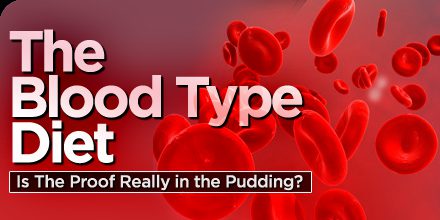The Blood Type Diet: Is the Proof Really in the Pudding?
Have you heard about the Blood Type Diet? It’s gotten some buzz lately and it’s worth talking about.
This article explores the concepts in the book “Eat Right 4 Your Type” by Dr. Peter J. D’Adamo, blended with my own experience as a fitness professional. You’ve probably heard of this diet, as the book was published way back in 1996 and has sold over 7 million copies worldwide.
In my 15+ years as a certified personal trainer and sports nutritionist, I’ve seen countless diet trends come and go. A good friend and coworker first told me about the blood type diet, and it definitely sparked my curiosity. So, I decided to put it to the test.
Disclaimer: This article is for informational purposes only and is not meant to treat or diagnose any condition. It is recommended that you speak with your doctor before trying the Blood Type Diet.
Table of contents

We all learn in school about the four main blood types: A, B, AB, and O. Dr. D’Adamo links each of these to a specific ancestral lifestyle and dietary plan. I encourage you to read the book to get the full picture, but here is a quick breakdown.
- Blood Type A (“The Cultivator”): This plan focuses heavily on vegetables and eliminates red meat, essentially a vegetarian diet. D’Adamo suggests this is because Type A ancestors were early farmers.
- Blood Type B (“The Nomad”): This group is described as having a strong digestive and immune system. They are the only blood type said to thrive on dairy products.
- Blood Type AB (“The Enigma”): As a mix of types A and B, this group is advised to follow a diet that combines the two, focusing on foods like tofu, seafood, and green vegetables.
- Blood Type O (“The Hunter”): Believed to be the oldest blood type, this group is encouraged to eat a high-protein diet rich in meat, similar to early hunter-gatherers.
How Does This Work Within the Blood Type Diet?
So what’s the mechanism behind these different diet plans? The theory hinges on proteins called lectins. Lectins are found in most plants and animals and can bind to sugar molecules.
D’Adamo claims that certain food lectins are incompatible with specific blood type antigens. He argues that eating the wrong lectins causes agglutination, a process where your blood cells clump together, leading to inflammation and disease. For example, the lectin in lima beans is said to be harmful to Type A individuals because it clumps their blood cells.
However, there is no solid scientific evidence to support this blood-type-specific lectin theory. In fact, a comprehensive 2013 review in the *American Journal of Clinical Nutrition* looked at over 1,400 studies and found no evidence to validate the diet’s health claims. Most lectins that are harmful to humans are reactive with all blood types, and cooking typically destroys them anyway.
As I’m a blood type A, the diet labels me a vegetarian. My plan says to avoid all red meat and only eat poultry, fish, and eggs a few times a week. My first thought was, “No way.” I enjoy steak as much as anyone.
Surprisingly, I found it wasn’t as hard as I expected to stick to the guidelines. I still get plenty of protein from approved sources like fish, poultry, eggs, soy products, nuts, and beans. A pro-tip I’ve found is to use a food tracking app like MyFitnessPal to ensure I’m hitting my protein goals without the red meat I used to rely on.
My Experience Trying the Diet
I went into this experiment with an open mind but a healthy dose of skepticism. To create a fair comparison, I kept my calorie intake, workouts, and cardio routine exactly the same. The only thing I changed was the food I ate, following the Type A plan.
After a couple of weeks, I was surprised to find I had lost body fat while my weight remained stable. For me, body composition is always more important than the number on the scale. It’s the difference between looking fit and just being thin.
Think about it. Two people can be the same height and weight, but one might have 10% body fat while the other has 20%. The person with lower body fat will look leaner and be healthier. That’s why I focus on body fat percentage with my clients.
The results were better than I expected. The diet’s recommendations made some sense for me personally. As a child, I was allergic to dairy and sugar, and even today, dairy products can upset my stomach. These are both foods my Type A diet says to avoid.
So, why did it work for me? The success I felt likely came from simply cleaning up my diet. I was cutting out processed foods and focusing on whole, natural foods. This is a principle supported by nearly all nutrition experts, including the Academy of Nutrition and Dietetics.
The diet forces you to plan your meals, which is something most people don’t do. When you’re hungry and unprepared, you’re more likely to grab fast food or something from a vending machine. Planning ahead is a cornerstone of any successful nutrition plan.
I know many people are skeptical, and they have good reason to be. Is this diet the magic bullet for weight loss? Probably not. The benefits most people see likely come from eating more whole foods and fewer processed ones, not from matching food to their blood type.
But until you try cleaning up your own diet, you’ll just be on the outside looking in. I feel the best I have in a long time, and you can too. Focusing on fresh, whole foods might just change your views and your body.
Is the Diet Safe?
The safety and effectiveness of the blood type diet are highly debated. While some people report positive results, there’s a significant lack of scientific evidence to support its core principles.
Here are a few key points to consider regarding its safety:
- Lack of Scientific Evidence: The main idea that your blood type should determine your diet isn’t backed by strong research. A 2020 study by the Physicians Committee for Responsible Medicine found that a plant-based diet was beneficial for people of all blood types, directly contradicting the diet’s claims.
- Potential Nutritional Deficiencies: Restricting entire food groups can lead to imbalances. For example, the Type O diet is low in grains and dairy, which could lead to a deficiency in calcium and fiber. The Type A diet, which avoids meat and dairy, could be low in vitamin B12 and iron.
- Oversimplifies Nutrition: Your nutritional needs depend on many factors, like age, activity level, and overall health. Relying only on blood type is an oversimplification of complex human biology.
- Not a One-Size-Fits-All Approach: Ironically, while pretending to be personalized, the diet lumps millions of people into four broad categories. True nutritional planning should be much more individualized.
- Potential for Misinterpretation: Following the diet too rigidly could lead to unhealthy, restrictive eating patterns. This is especially risky for people with specific health needs, like pregnant women or those with medical conditions.
Who Should NOT Try the Blood Type Diet?
Certain groups should be especially cautious or avoid this diet completely:
- People with Medical Conditions: If you have diabetes, heart disease, or kidney problems, you need a carefully managed diet. For example, someone with chronic kidney disease needs to control their protein intake, which could be dangerously high on the Type O diet.
- Pregnant or Breastfeeding Women: These life stages require increased nutrients to support both mother and baby. The restrictive nature of some of these diet plans may not provide adequate nutrition.
- People with Food Allergies or Intolerances: The diet might recommend foods you’re allergic to. Always prioritize your known dietary needs over these general guidelines.
- Individuals with a History of Eating Disorders: Any restrictive diet can be a trigger for those with a history of eating disorders. It’s better to focus on a balanced, non-restrictive approach to food.
- Athletes in Training: From my experience as a coach, athletes have high energy demands. The restrictions of a diet like the vegetarian plan for Type A could make it difficult to get enough calories and protein for peak performance and recovery.
Frequently Asked Questions About the Blood Type Diet
1. Is there any scientific proof for the Blood Type Diet?
No, there is no credible scientific evidence that supports the theory that your diet should be based on your blood type. Major studies and systematic reviews have found that any health benefits from these diets are due to eating healthier foods in general, not because the diet is matched to a specific blood type.
2. What are lectins, and are they really dangerous?
Lectins are proteins found in many foods that bind to carbohydrates. While some raw lectins (like those in uncooked kidney beans) can be toxic, most are harmless and are destroyed during the cooking process. The idea that specific lectins target specific blood types is not supported by science.
3. Why do some people lose weight on this diet?
People often lose weight on the blood type diet because it encourages eating whole, unprocessed foods and eliminating junk food, sugary drinks, and refined carbohydrates. This general improvement in diet quality, rather than the blood type theory itself, is the likely reason for weight loss and improved health markers.
4. Do I need to know my blood type to follow this diet?
Yes, the entire premise of the diet is based on your specific blood type (A, B, AB, or O). You can find out your blood type through a simple blood test from your doctor or at a blood donation center.
Resources:
D’Adamo, Peter J. Eat Right 4 Your Type. New York City: Putnam, 1996.


*Disclosure: This article may contain affiliate links or ads, which means we earn a small commission at no extra cost to you if you make a purchase through these links. These commissions help support the operation and maintenance of our website, allowing us to continue producing free valuable content. Your support is genuinely appreciated, whether you choose to use our links or not. Thank you for being a part of our community and enjoying our content.
PLEASE CONSIDER SHARING THIS ON YOUR SOCIAL MEDIA TO HELP OTHERS LEARN MORE ABOUT THIS TOPIC.





